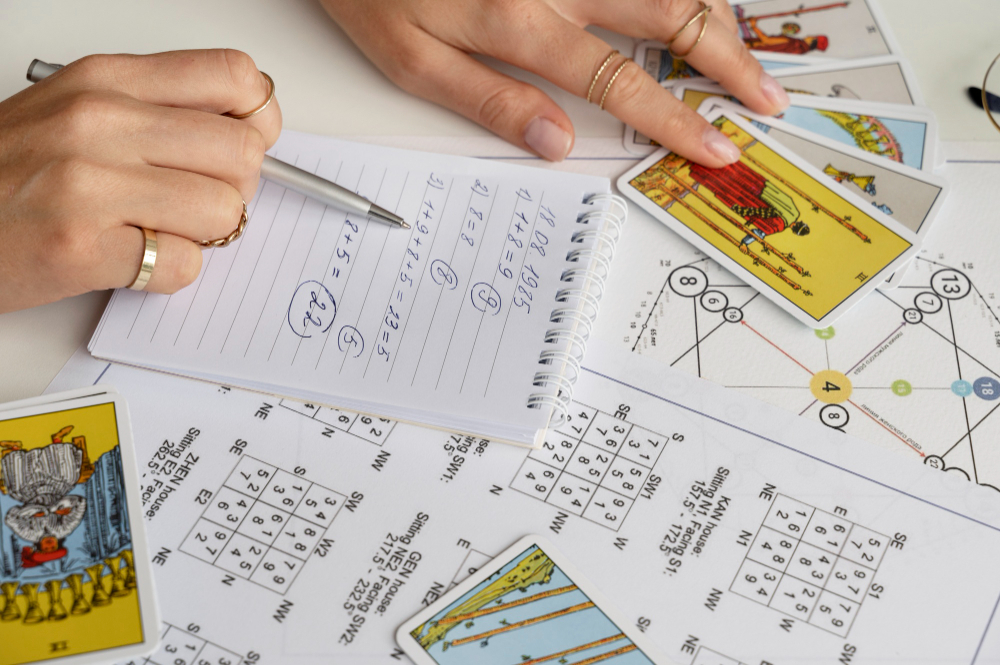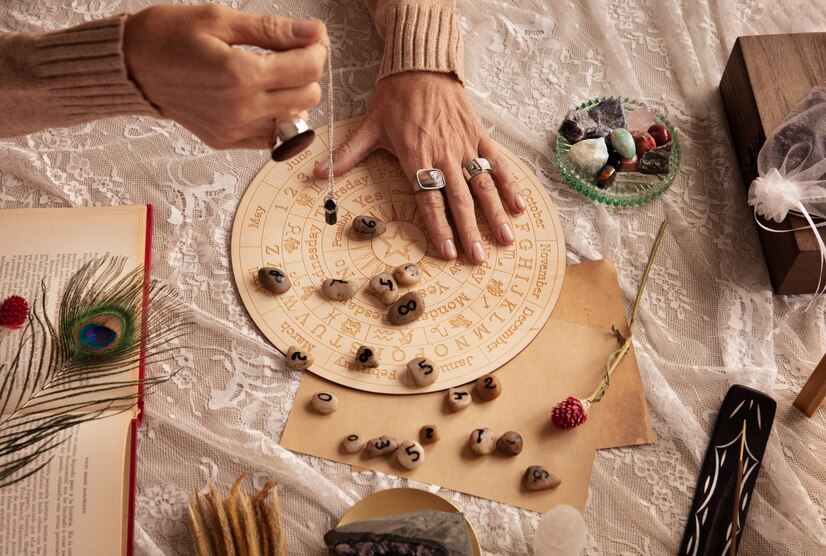This analysis explores the foundational principle upon which Jyotish (Vedic Astrology) rests: the law of Karma. We examine the Concept of Karma in Vedic Astrology from traditional philosophical, contemporary psychological, student learning, and practical application perspectives. Understanding Karma – the universal law of cause and effect governing actions and their consequences across lifetimes – is essential for interpreting the Janma Kundali (birth chart) not as rigid fate, but as a map of Prarabdha Karma (karma allotted for this life) and a guide for navigating our Destiny vs Free Will dynamic through conscious action (Kriyamana Karma).
Traditional Foundation (The Philosophical & Scriptural View)
Key Findings: Traditional Jyotish is inseparable from the Vedic philosophical understanding of Karma. Actions (karma) performed in past lives create impressions (samskaras) and generate results (phala) that manifest in the present life as innate tendencies, circumstances, opportunities, and challenges, all reflected in the planetary positions at birth (the Kundali). Jyotish is seen as the science (‘Vidya’) that illuminates this karmic pattern.
Detailed Analysis:
Classical Vedic philosophy categorizes Karma into three main types:
- Sanchita Karma: The total accumulated sum of all actions from all past existences, stored like a vast cosmic ledger.
- Prarabdha Karma: That portion of Sanchita Karma allotted to be experienced in the current lifetime. The Janma Kundali (birth chart) is considered the primary map of Prarabdha Karma – the planetary positions indicate the specific karmic fruits (both positive and negative) ripe for experience.
- Kriyamana Karma (or Agami Karma): The actions being performed in the present life, driven by free will (Purushartha). These actions create new karma that will generate future results, shaping Agami Karma (future destiny) and contributing back to Sanchita Karma. Jyotish aims to understand the Prarabdha unfolding and guide conscious Kriyamana action.
- Technique Deep Dive: Identifying Karmic Patterns in the Chart: Specific planetary placements, aspects (Drishti), house conditions (especially Dusthanas 6, 8, 12), and Yogas (combinations) are interpreted as indicators of specific types of Prarabdha Karma (e.g., afflictions to the 5th house/lord indicating past karma related to children; strong Dhana Yogas indicating past meritorious deeds bringing wealth).
- Expert Insight (Traditional Source): “Yatha Beejam Tatha Phalam” (As the seed, so the fruit). “Every action inevitably produces a result, just as every seed produces its corresponding plant. The birth chart reveals the fruits of past actions ready to manifest.” – Paraphrased principle from Vedic philosophical texts (like Bhagavad Gita, Upanishads).
- Hidden Wisdom: Role of Ishvara (God/Divine Will): While Karma is a fundamental law, Vedic philosophy also incorporates divine grace and intervention (Ishvara Kripa). Upayas (remedies) in Jyotish often involve propitiating deities associated with planets, seeking divine assistance in mitigating challenging karma.
- Astrological Framework Map Suggestion: A cyclical diagram showing Sanchita Karma leading to Prarabdha Karma (represented by a Kundali), which influences Kriyamana Karma (actions/free will), creating Agami Karma which feeds back into Sanchita.
- Critical Considerations: Misunderstanding Karma as purely fatalistic negates the crucial role of Kriyamana Karma and Purushartha (free will, self-effort). Jyotish guides action within the karmic framework, not passive acceptance.
Contemporary Interpretation Framework (The Psychological & Evolutionary View)
Key Findings: Contemporary Jyotish interprets Karma through a lens that includes psychological patterns, evolutionary growth, and self-awareness. Prarabdha Karma reflected in the chart is seen not just as reward/punishment, but as the set of tendencies, talents, complexes, and life situations designed to facilitate the soul’s learning and evolution in this lifetime.
Detailed Analysis:
Modern practitioners explain challenging placements as representing ingrained psychological patterns or ‘samskaras’ stemming from past actions, which need conscious awareness and effort (Kriyamana Karma) to transform. Beneficial placements represent positive samskaras or talents earned.
The focus shifts from mere acceptance of fate to understanding the purpose behind the karmic patterns (Astrology Life Lessons) and using free will (Destiny vs Free Will) to navigate them consciously for growth and liberation (Moksha).
- Technique Deep Dive: Rahu-Ketu Axis as Karmic Indicators: The nodal axis is seen as profoundly indicative of the karmic trajectory – Ketu representing deeply ingrained past-life patterns and skills (part of Prarabdha), and Rahu representing the area of intense desire, lessons, and future karmic development required in this life (driving Kriyamana action).
- Expert Insight (Modern Jyotishi): “Your birth chart is a reflection of the karmic lessons your soul chose to work on in this life. Understanding these patterns empowers you to engage with them consciously, transforming challenges into growth opportunities through mindful action.” – Contemporary Jyotish Practitioner.
- Alternative Approaches: Exploring Karma through the lens of evolutionary astrology (within a Vedic context), focusing on soul contracts, or integrating concepts from depth psychology regarding complexes and shadow work as manifestations of samskaras.
- Astrological Framework Map Suggestion: A visual linking specific chart factors (e.g., Saturn placement, 8th house) to concepts like ‘Karmic Lessons’, ‘Samskaras’, ‘Growth Areas’, ‘Psychological Patterns’. Show free will (Kriyamana) interacting with the Prarabdha map.
- Critical Considerations: Overly psychologizing Karma can sometimes diminish the understanding of tangible consequences and the importance of ethical action emphasized in traditional views. Balancing psychological insight with the core principles of cause/effect is key.
Learning Path Analysis (The Student’s Perspective)
Key Findings: For students, grasping the Concept of Karma in Vedic Astrology is fundamental and distinguishes Jyotish significantly from most Western astrology. Understanding the three types of Karma (Sanchita, Prarabdha, Kriyamana) and seeing the birth chart as a map of Prarabdha is a core conceptual step. Reconciling fate (Prarabdha) with free will (Kriyamana/Purushartha) is a crucial intellectual and philosophical challenge.
Detailed Analysis:
Students learn to interpret chart placements not just as personality traits but as indicators of karmic inheritance. They study how different Grahas (like Shani as the primary karmic agent) and Bhavas (especially Dusthanas) reflect specific types of karmic challenges or rewards. The role of Dashas (planetary periods) in timing the unfolding of Prarabdha Karma is a major area of study. Understanding How Birth Chart Shows Karma involves synthesizing multiple chart factors.
- Real-World Application: Reflecting on one’s own life experiences – recurring patterns, innate talents, persistent challenges – through the lens of Prarabdha Karma. Making conscious choices understanding they create future Karma (Kriyamana/Agami).
- Student Question: “If my chart shows my Prarabdha Karma, does that mean everything is predetermined?” Answer: No. The chart shows the tendencies and probabilities based on past actions – the landscape you are born into. How you navigate that landscape using your effort and choices (Purushartha/Kriyamana Karma) significantly influences the actual outcomes and creates future karma. It’s a dynamic interplay, not rigid predetermination. This addresses the Destiny vs Free Will question.
- Expert Insight (Jyotish Student): “Understanding Karma as the foundation changed everything. Seeing my chart as a result of past actions, and my current actions as shaping the future, gave my studies and life choices so much more meaning and responsibility.”
- Common Misconceptions vs. Reality: Misconception: Karma is only about punishment or bad things. Reality: Karma is the neutral law of cause and effect; positive actions (punya) create positive results (good fortune, talents), while negative actions (papa) create suffering. The chart reflects both. Misconception: You can completely erase bad karma with remedies. Reality: Upayas (remedies) can help mitigate negative karmic influences and align one’s energy, but Prarabdha generally needs to be experienced, albeit potentially with lessened intensity through effort and grace.
Practical Implementation (The Jyotish Practitioner’s Application)
Key Findings: Practical Jyotish uses the understanding of Karma to provide context for clients’ life situations, explain the root causes of challenges and blessings, assess the timing of karmic events (via Dashas/Transits), and recommend appropriate actions (including Upayas/remedies) to navigate Prarabdha and generate positive Kriyamana Karma.
Detailed Analysis:
Consultants interpret the Kundali as a map of the client’s karmic journey in this life. Difficult placements are explained not as random misfortune but as opportunities to resolve past karmic debts or learn crucial lessons. Strengths and fortunate placements are seen as the results of past merits.
Guidance often involves accepting the Prarabdha landscape while empowering the client to exercise their free will (Purushartha) wisely through ethical conduct, appropriate effort, and spiritual practices (Sadhana). Recommending Upayas is aimed at smoothing the path and aligning with divine energies.
- Real-World Application: Understanding a chronic illness (6th house affliction) as Prarabdha and using disciplined effort (Shani influence) and remedies alongside medical care. Seeing relationship struggles (7th house/Shukra issues) as karmic patterns requiring conscious work on oneself (Kriyamana). Utilizing innate talents (strong planetary placements) as positive Prarabdha to fulfill one’s Dharma.
- Technique Deep Dive: Dasha System as Karmic Timing: The sequence and nature of Vimshottari Dasha periods (or other Dasha systems) are seen as directly timing the fructification of specific Prarabdha Karmas associated with the Dasha lords. Analyzing the Dasha lord’s natal condition reveals the likely quality of the period.
- Expert Insight (Jyotish Consultant): “My role is to help clients understand their karmic blueprint (Prarabdha) shown in the chart, accept what needs to be experienced, and empower them to make conscious choices (Kriyamana) that align with their dharma and create a better future. Karma is the context for everything.”
- Practical Tip: Identify the placement and condition of Shani (Saturn) in your chart. It is often considered the primary agent delivering karmic results (both challenging and rewarding through perseverance). Understanding its lessons is key to navigating your Karma effectively.
- Chart Example Suggestion: A sample Kundali showing both challenging placements (e.g., afflicted Dusthana lord) labeled ‘Prarabdha Challenge’ and strong placements (e.g., powerful Raja Yoga) labeled ‘Prarabdha Blessing’, illustrating both sides of karmic inheritance.
PERSPECTIVE INTEGRATION MATRIX
| Feature | Traditional View | Contemporary View | Student Focus | Practical Use | Integration Point |
| Core Meaning | Cause/Effect Across Lives | Evolutionary Lessons/Patterns | Sanchita/Prarabdha/Kriyamana | Explain Life Context, Guide Action | Understanding patterns (contemp) provides context for traditional cause/effect applied practically. |
| Chart Role | Map of Prarabdha Results | Blueprint for Soul Growth | Identify Karmic Indicators | Diagnose Root Cause, Assess Timing | Chart shows results (trad) which are lessons (contemp) diagnosed for practical guidance (prac). |
| Free Will | Kriyamana/Purushartha shapes Agami | Conscious Navigation of Patterns | Destiny vs Free Will Balance | Empower Client Choice, Suggest Upayas | Understanding balance (student) allows empowering client choices within karmic limits (practical). |
| Focus | Consequences, Duty (Dharma) | Self-Awareness, Transformation | Grasping Core Concepts | Acceptance, Ethical Action, Remedies | Awareness (contemp) facilitates acceptance & ethical action (practical) aligned with dharma (trad). |
MISCONCEPTION ANALYSIS
| Common Belief | Jyotish/Vedic Reality |
| Karma is fatalistic; nothing can be changed. | The chart shows Prarabdha tendencies, not immutable events. Kriyamana Karma (present actions/free will) constantly shapes future outcomes and can modify Prarabdha’s impact. |
| Karma is only an Eastern/Hindu concept. | While central to Vedic thought, the principle of cause and effect (“reaping what you sow”) is a universal ethical and natural law recognized in many traditions. |
| You can know all your past lives via Jyotish. | Jyotish primarily reveals the results (Prarabdha) of past actions manifesting now. While some techniques hint at past patterns (e.g., via Ketu), detailed past life recall is not its main function. |
| Good people shouldn’t suffer if Karma is real. | Prarabdha Karma includes results from actions in previous lives. Suffering in this life might be due to past negative karma, regardless of current virtue. Present virtue creates future good karma. |
KEY DEVELOPMENTS & FUTURE DIRECTIONS (Evolution Timeline)
- Vedic/Upanishadic Period: Concept of Karma and Rebirth firmly established in philosophical texts, forming the bedrock for Jyotish.
- Classical Jyotish Period: Detailed correlations between planetary placements and specific karmic results codified by sages like Parashara. Dasha systems developed to time karmic unfoldment.
- Medieval Period: Further commentaries linking specific Yogas and afflictions to types of Karma (e.g., curses from past lives). Emphasis on Upayas (remedies).
- Modern Period: Integration with psychological concepts – Karma seen as samskaras, patterns, evolutionary lessons. Increased emphasis on free will and conscious participation in navigating karma.
- Contemporary: Exploration of collective karma, epigenetic parallels. Continued refinement of linking chart factors to specific karmic themes. Ethical discussions around prediction vs. empowerment.
- Future: Potential deeper integration with consciousness studies, continued exploration of the interplay between genetics/epigenetics and Prarabdha Karma, ongoing refinement of remedial measures.
SYNTHESIS & RECOMMENDATIONS (Celestial Integration)
The law of Karma is the operating system of Jyotish, providing profound context for life’s experiences. Integrating perspectives means respecting its deep philosophical roots and consequences (Traditional), understanding its role in psychological growth and soul evolution (Contemporary), mastering the types of Karma and their reflection in the chart (Student), and applying this wisdom to navigate life consciously and ethically (Practical).
Living in alignment with Karma involves understanding your Prarabdha map, accepting what is, and using your Purushartha (free will) to create positive Kriyamana Karma.
Recommendations:
- Study the Three Karmas: Understand the distinction between Sanchita, Prarabdha, and Kriyamana/Agami Karma.
- View Your Chart as Prarabdha: Interpret planetary placements and house conditions as reflections of karmic patterns ripe for experience.
- Identify Key Karmic Indicators: Pay special attention to Shani, Rahu/Ketu, the Lagna Lord, and Dusthana houses (6, 8, 12).
- Embrace Responsibility: Recognize that your present actions (Kriyamana) shape your future. Practice ethical conduct (Yama/Niyama).
- Utilize Free Will Wisely: Use the insights from your chart not for passive acceptance, but to make informed choices and exert effort (Purushartha) in alignment with your Dharma.
- Explore Remedies Consciously: Understand Upayas as tools to mitigate suffering and align energy, used alongside self-effort and acceptance.
FURTHER AREAS OF STUDY
- Introduction to Dasha Systems (Timing the unfolding of Prarabdha Karma)
- Rahu and Ketu (The Nodes) Explained in Jyotish (Primary karmic axis)
- Shani (Saturn) in Jyotish (The great karmic teacher)
- The Significance of Bhavas (Houses) in Jyotish (esp. Dusthanas 6, 8, 12)
- Upayas (Remedial Measures) in Vedic Astrology
- Dharma and Purushartha (Life Purpose and Free Will) in Vedic Thought.












